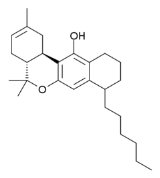
AM-855
Encyclopedia
AM-855 is an analgesic
drug which is a cannabinoid agonist
. It is a derivative of Δ8Tetrahydrocannabinol
with a conformationally restricted side chain which has been bound into a fourth ring fused to the aromatic A-ring of the cannabinoid skeleton. AM-855 is an agonist at both CB1
and CB2
with moderate selectivity for CB1, with a Ki
of 22.3nM at CB1 and 58.6nM at CB2.
Analgesic
An analgesic is any member of the group of drugs used to relieve pain . The word analgesic derives from Greek an- and algos ....
drug which is a cannabinoid agonist
Agonist
An agonist is a chemical that binds to a receptor of a cell and triggers a response by that cell. Agonists often mimic the action of a naturally occurring substance...
. It is a derivative of Δ8Tetrahydrocannabinol
Tetrahydrocannabinol
Tetrahydrocannabinol , also known as delta-9-tetrahydrocannabinol , Δ1-THC , or dronabinol, is the main chemical psychoactive substance found in the cannabis plant. It was first isolated in 1964. In pure form, it is a glassy solid when cold, and becomes viscous and sticky if warmed...
with a conformationally restricted side chain which has been bound into a fourth ring fused to the aromatic A-ring of the cannabinoid skeleton. AM-855 is an agonist at both CB1
Cannabinoid receptor type 1
The cannabinoid receptor type 1, often abbreviated to CB1, is a G protein-coupled cannabinoid receptor located in the brain. It is activated by endocannabinoid neurotransmitters including anandamide and by the compound THC, found in the psychoactive drug cannabis.-Expression:The CB1 receptor is...
and CB2
Cannabinoid receptor 2 (macrophage)
Cannabinoid receptor 2 , also known as CB2 or CNR2, is a G protein-coupled receptor from the cannabinoid receptor family, which in humans is encoded by the CNR2 gene...
with moderate selectivity for CB1, with a Ki
Dissociation constant
In chemistry, biochemistry, and pharmacology, a dissociation constant is a specific type of equilibrium constant that measures the propensity of a larger object to separate reversibly into smaller components, as when a complex falls apart into its component molecules, or when a salt splits up into...
of 22.3nM at CB1 and 58.6nM at CB2.

